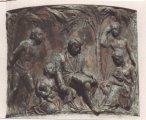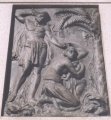|
 |
|
| |
 |
|  |
|
Details:
|
|
|
Sculptor:
John Mossman
(1817-1890)
Assisted by:
Francis Leslie
(1833-94)
James Pittendrigh Macgillivray
(1856-1938)
Designers of pedestal:
Campbell Douglas & Sellars
Foundry: Cox & Sons
Location: Cathedral Square, Townhead, Glasgow
Date executed: 1875-9
|
|


|
The statue of David Livingstone stands in Cathedral Square, at the west end of
the Cathedral Precinct, between the Royal Infirmary and St Mungo's Museum of Religious
Life and Art, facing Castle Street. This is the third site that the statue has occupied,
having originally been erected on the west side of George Square in 1879, and then moved
to an island site in Cathedral Square in 1960, a few yards to the south of its present
location, where it faced Provand's Lordship. It was moved here in 1990, as part of the
creation of the precinct as a processional route to Glasgow Cathedral.
|


|
The statue commemorates David Livingstone (1813-73), the Scottish born doctor,
missionary and explorer, whose exploits in Africa and his discovery by Henry Morton
Stanley ('Dr Livingstone, I presume?') have become legendary. He was born in Blantyre
and studied medicine and science in Glasgow at the Andersonian (now Strathclyde)
University in George Street. After graduating in 1840, he was sent to southern Africa by
the London Missionary Society and began exploring and charting hitherto unexplored
territory and discovered Lake Ngami. During his later explorations he discovered Lake
Nyasa and the Victoria Falls, and attempted to supress the Arab driven slave trade. Joined
by Stanley for further expeditions, Livingstone died at Ilala, where his heart was buried
under a tree before his body was conveyed to London for burial in Westminster Abbey.
|


|
Mossman's commission for the statue was won in competition against William Brodie of
Edinburgh, and William Calder Marshall of London, in April 1875. All three designs were
submitted anonymously with mottos to identify them, the winner being submitted under the
motto: Clutha. By December 1876, the clay model was ready for casting and the
finished bronze was exhibited at its foundry in Thames Ditton, Surrey, a year later (also
on show was Mossman's statue of Thomas Campbell, which was also destined for George
Square). The statue was eventually unveiled in March 1879, by James White of Overtoun, with
the sculptor and members of Livingstone's family in attendance.
The statue stands 2.4m high, and is a straightforward portrait of Livingston gazing into
the distance. He holds a bible in front of him in his left hand, and reaches for his
famous cap which rests on a tree stump draped with a cloth at his right side, with his other hand.
Behind his left foot lies a sextant, an astrolabe and an ankle shackle, which serve to identify him
as an explorer and anti-slavery campaigner.
|


|
The pedestal was designed by Campbell Douglas & Sellars, and includes three narrative relief
panels depicting Livingstone as a missionary (front), an explorer (right side) and his fight against
the slave trade (left side), whilst a fourth panel on the rear of the pedestal features his name and
dates of birth and death.
|
|
Click on an image to enlarge it.
|
Click here to return to the TOP.
|
|
|
All images and biographies are our copyright and may not be reproduced
in any form whatsoever without our express permission.
|
|
|
|
|
For sculpture and architecture: we have over 300 biographies of sculptors and architects connected with Glasgow, Scotland.
|
|
| Copyright 2001-2024 glasgowsculpture.com. |
|
|
| |
|
 |
|

